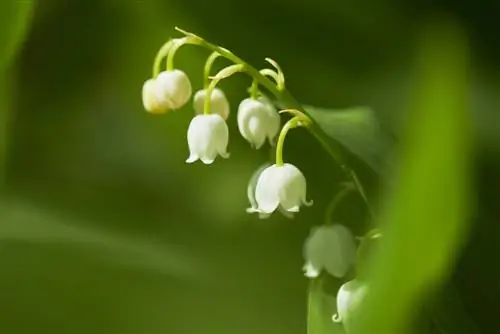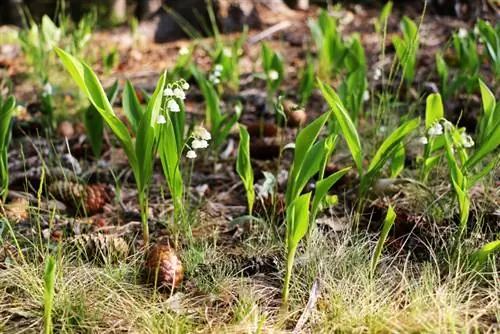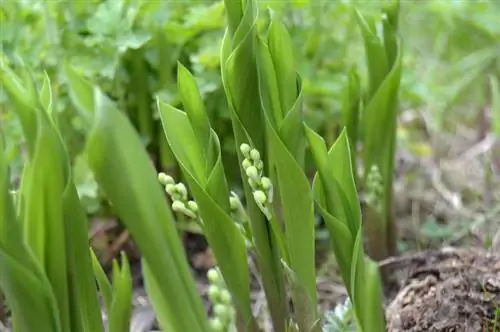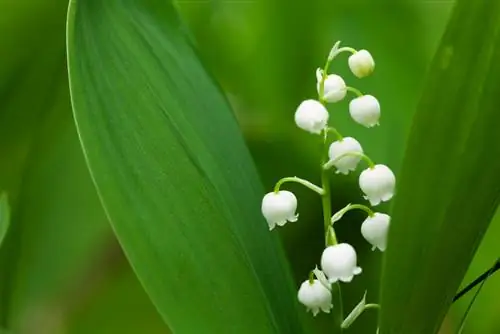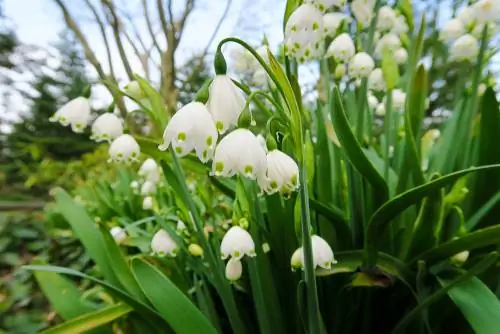- Author admin [email protected].
- Public 2023-12-16 16:46.
- Last modified 2025-01-23 11:21.
One of the most popular and well-known spring flowers is the lily of the valley, which attracts numerous insects with its lovely scent. In our latitudes it can be found both wild and in many parks and home gardens.

How do I care for lily of the valley in the garden?
Lilies of the valley need shade, moist and humus-rich soil. Plant them in groups 20cm apart and water adequately. After flowering, cut off inflorescences and use leaf soil as mulch. Lilies of the valley are hardy, but watch out for rust fungi and gray mold.
Plant profile:
- Botanical name: Convallaria majalis
- German names: lily of the valley, lady's tear, f altrian flower, may flower, mail lily, eye herb, lily of the valley
- Class: Monocotyledons (Liliopsida)
- Genus: Lily of the valley family (Convallaria)
- Family: Asparagus family (Asparagaceae)
- Growth height: 10 to 30 centimeters
- Main flowering period: April to June
- Leaf color: Dark green, clearly shiny
- Leaf shape: Elliptical, grown together in pairs
- Flower color: white, cultivated forms can also be colored pink)
- Flower shape: little bells that all point in the same direction and consist of five to thirteen individual flowers
- Fruits: Bright red berries
Origin
The lily of the valley is native to Europe, Asia and North America and can even be found in these areas at altitudes of up to 1900 meters. It thrives primarily in open beech and deciduous forests on slightly calcareous soils. Here the little scent princess forms large carpets of flowers.
Plant symbolism
Lily of the valley stands for purity, festivity, bliss and awakening love. But they are not just symbols of luck and love. They are often depicted in medieval panel paintings because of their ambivalence: both the Madonna often holds a bouquet of lily of the valley in her hands and martyrs condemned to death.
Planting and care
Lily of the valley is undemanding. In the shade under trees, the runners of the fragrant spring bloomers even hold their own against strong root pressure. The plant prefers moist, humus-rich soil. However, the delicate plant does not like full sun.
Lily of the valley germs are planted in groups about twenty centimeters apart. Water sufficiently so that the young plants grow well. If the lilies of the valley have faded, you should cut out the flower clusters; the leaves remain.
Mulch with a thick layer of leaf mold in autumn. Further fertilizer applications are not necessary.
Diseases and pests
Lilies of the valley are very robust and are rarely attacked by a variant of the rust fungus. If you discover this, you should cut off all diseased parts of the plant and dispose of them with household waste.
Gray mold occasionally appears. Then treat the lily of the valley with commercially available products, otherwise the plant will rot and die. The spores of the fungus could also infect other plants.
The lily chicken and its larvae like to settle on lilies of the valley. Here it has proven useful to collect the beetles and rinse off the larvae, which are usually found under the leaves, with the garden hose. No further measures are necessary.
Tip
In 2014, the lily of the valley was named poisonous plant of the year. All parts of the plant are highly poisonous, and this effect does not disappear even when dried. When collecting wild garlic, there is a risk of confusing the two plants. If you crush lily of the valley leaves, they do not smell intensely of garlic, unlike the popular herb. However, if in doubt, you should consult an expert who is familiar with the differences between the plants.

